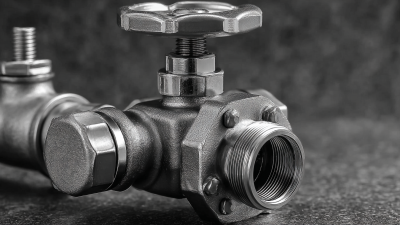In modern fluid control systems, the importance of Angle Valves cannot be overstated. These critical components are designed to regulate the flow of liquids and gases with precision, making them indispensable in various industries, including oil and gas, water treatment, and manufacturing. According to a market report by Global Market Insights, the angle valve market is projected to surpass USD 5 billion by 2027, driven by the increasing demand for efficient fluid control solutions. As industries evolve and the complexity of processes grows, understanding the role of Angle Valves becomes essential for engineers and professionals. By effectively managing fluid dynamics, these valves not only enhance system performance but also contribute significantly to safety and sustainability efforts. This blog will explore the nuances of angle valves, their operational mechanisms, and their profound impact on various industrial applications.

 Angle valves play a crucial role in fluid control systems by regulating the flow of liquids and gases in various industrial applications. Typically designed with an angled body, these valves facilitate efficient channeling of fluids, which is essential for maintaining system performance and integrity. According to a report by the Global Valve Market, the angle valve segment is projected to grow at a CAGR of 5.2% over the next five years, reflecting increasing demand in sectors such as oil and gas, water treatment, and manufacturing.
Angle valves play a crucial role in fluid control systems by regulating the flow of liquids and gases in various industrial applications. Typically designed with an angled body, these valves facilitate efficient channeling of fluids, which is essential for maintaining system performance and integrity. According to a report by the Global Valve Market, the angle valve segment is projected to grow at a CAGR of 5.2% over the next five years, reflecting increasing demand in sectors such as oil and gas, water treatment, and manufacturing.
The functionality of angle valves is grounded in their unique design, which allows for smooth flow transitions. By diverting fluid at an angle, these valves minimize turbulence and reduce pressure drop, enhancing overall system efficiency. This is particularly important in applications where maintaining precise fluid control is critical. A study by the American Society of Mechanical Engineers indicates that proper implementation of angle valves can improve energy efficiency by up to 15% in large-scale industrial systems, thereby not only optimizing operations but also contributing to cost savings and sustainability initiatives.
Angle valves play a crucial role in fluid control systems across various industries, demonstrating versatility in applications ranging from HVAC to chemical processing. According to market insights, the isolation valve market, expected to reach $5.8 billion by 2033, reflects the growing demand for efficient fluid management solutions. Angle valves, specifically, are instrumental in facilitating proper flow direction and control, which is vital for maintaining system efficiency and safety.
In the HVAC sector, angle valves find critical applications in both residential and commercial systems. They enable precise control of water and refrigerants, contributing to energy efficiency and temperature regulation. As the HVAC market continues to expand, projected to grow significantly in the coming years, the reliance on effective valves like angle valves will become increasingly apparent. With their ability to isolate sections of the system, angle valves also support maintenance operations, minimizing downtime and enhancing overall system reliability. Given these trends, the importance of angle valves in fluid control systems is clear, highlighting their impact across numerous industries.
| Industry | Application | Fluid Type | Angle Valve Type | Benefits |
|---|---|---|---|---|
| Oil & Gas | Pipeline Flow Control | Crude Oil | Optimized Angle Valve | Improved Flow Efficiency |
| Water Treatment | Chemical Injection | Water | Manual Angle Valve | Precise Flow Control |
| Food & Beverage | Brewery Processes | Wort | Stainless Steel Angle Valve | Hygienic Operation |
| Pharmaceutical | Process Isolation | Active Ingredients | High Purity Angle Valve | Compliance with Standards |
| HVAC | Chilled Water Systems | Water | Electric Angle Valve | Energy Efficiency |
Angle valves play a crucial role in fluid control systems, providing significant benefits for a variety of industries. One of the primary advantages of using angle valves is their ability to manage fluid flow with increased efficiency. According to a report from the International Society of Automation, angle valves can enhance control accuracy by up to 20% compared to traditional straight-line valves. This increased precision is particularly beneficial in sectors like oil and gas, where the economical transport and processing of fluids can drastically affect operational costs.
Additionally, the design of angle valves promotes a reduction in pressure drop, which can lead to decreased energy consumption in fluid systems. The Flow Control Industry Report indicates that the implementation of angle valves resulted in energy savings of 10-15% for many manufacturing plants. These valves facilitate smoother flow paths, which not only improves the overall efficiency of systems but also extends the lifespan of associated equipment. By minimizing wear and tear on pumps and piping, angle valves contribute to lower maintenance costs and reduced downtime, making them an invaluable asset in modern fluid control applications.
Angle valves play a crucial role in fluid control systems, particularly in maintenance routines aimed at ensuring optimal performance. Regular upkeep is vital, as it can significantly impact the safety and efficiency of industrial operations. According to the ISA-75 standards, effectively designed and maintained control valves are essential for supporting reliability in various applications. Ensuring that angle valves are functioning correctly can prevent costly downtimes and enhance system performance, which is crucial for industries relying on precise fluid management.
Maintenance tips for angle valves should include regular inspection for wear and tear, as well as proper cleaning to avoid buildup that could impede functionality. It’s advisable to monitor operating pressures and flow rates, as deviations can indicate potential issues that could lead to failures. Furthermore, lubricant applications should be in accordance with manufacturer specifications to maintain optimal performance levels. Implementing periodic adjustments in line with industry best practices can further optimize performance, extending the service life of angle valves and maintaining the integrity of fluid control systems.

As industries continue to evolve, the significance of angle valves in fluid control systems is set to expand, driven by emerging trends in technology and the increasing need for efficiency. A recent report by MarketsandMarkets predicts the global valve market will grow from $89 billion in 2021 to $122 billion by 2026, with the angle valve segment experiencing notable demand due to its space-saving design and efficient flow control capabilities. Advances in smart valve technology, including IoT integration, are enhancing the effectiveness of angle valves, enabling real-time monitoring and remote control, which minimizes downtime and optimizes performance.
**Tip:** For industries seeking to implement angle valves, consider investing in smart technology that allows for predictive maintenance. This can lead to significant cost savings and improved reliability over time.
As manufacturers face pressures to adopt sustainable practices, angle valves are increasingly being designed with eco-friendly materials and processes. According to a report from Fortune Business Insights, the focus on sustainability is expected to boost the use of recyclable materials in valve production by over 30% in the next five years. This shift not only aligns with global environmental goals but also caters to the growing consumer demand for sustainable industrial solutions.
**Tip:** When selecting angle valves for your projects, prioritize those made from environmentally friendly materials to enhance your company’s sustainability credentials and appeal to eco-conscious clients.






